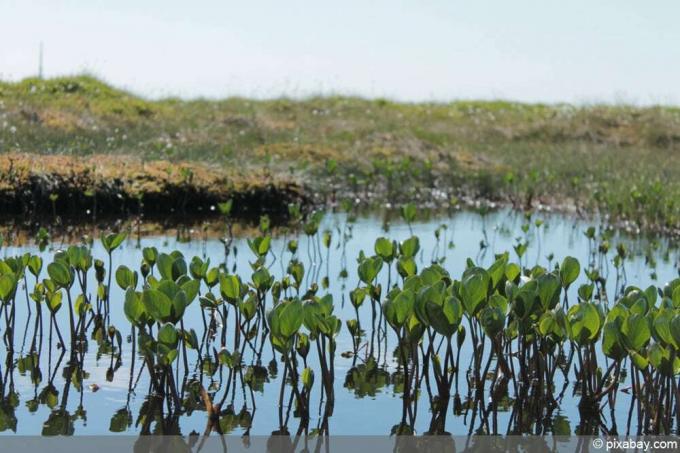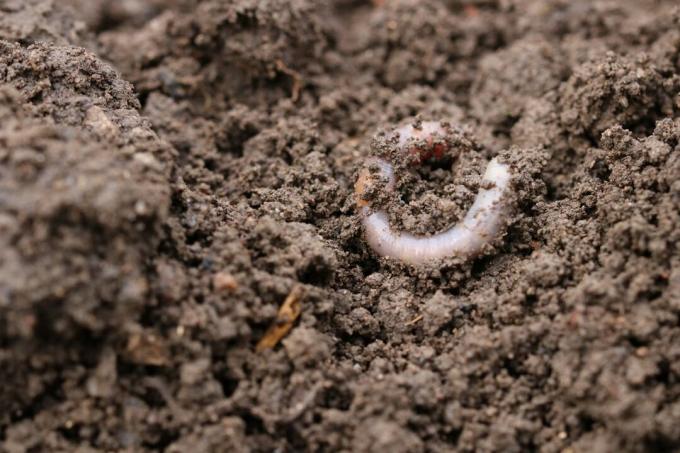

Table of contents
- Origin of peat species
- black peat origin
- white peat origin
- The differences
- potting soil
- Other uses
Peat is a popular choice for plants to thrive in the garden. A distinction is made here between two types, black and white peat. But what is the composition of these types of peat, are there big differences here? And when should one or the other species be used for your own garden bed. The following article deals with these questions.
Origin of peat species
In general, all types of peat originate from the deposits in a bog. The remains of the plants collect here and decompose over the years in the standing water. Over time, more and more nutrients are accumulated, and the dead plant remains cause the lake to silt up more and more over the years. The first thing that is created is the fen, under which there is still groundwater. Only when the surface detaches itself from the groundwater does the raised bog develop. In the raised bog there is no longer any groundwater under the individual layers of peat. The bottom first layer is coal, only above that can the different types of peat be used for the garden. These are the following:
- over the coal lies a layer of black peat
- above this lies the brown peat layer
- on top lies the white peat
A bog needs up to 10,000 years until all layers have formed. Since other plants have settled in the bogs that can cope well with the soil conditions, the emergence and development do not stop either. On average, however, only one millimeter of peat can be expected per year.
Tip:
271 million hectares of bogs are known worldwide. In Finland, about a third consists of peat soil. Nevertheless, its use is controversial, especially in local private gardens.
black peat origin
Black peat is a very old substance that has matured over thousands of years. So you can find it in the moors, which have arisen from standing water and dead plant parts. The moors consist of different layers, with the black peat forming the bottom layer and thus greater pressure exposed and more advanced in decomposition as this is also the oldest stratum in one Moor acts. There are moor areas all over the world, but a distinction must be made between low and high moors. However, the black peat for garden use is only found in the raised bogs.
composition
The black peat needs at least 30% organic substances in order to receive the designation. The remaining 70% consists mainly of water and minerals. Any organic matter below it is referred to as peat soil or wet humus. In addition, this type of peat has a very low pH value of between 3 and 4 and is therefore often used in very calcareous garden soils to lower the very high pH value.
use
So that the black peat can be used in the garden bed, it must be wet and frozen over the winter. Particularly high-quality garden peat from the trade has been frozen through for a long time. As a result, when it is later submerged in the garden soil, it shrinks less and can absorb more water. As a rule, it can then store four times its weight in water. Because garden peat lowers the pH of the soil, it is needed for various plants, which include the following:
- all azalea species
- rhododendron
- many vegetables
- some potted plants
- blueberries
- all bog plants

However, care should be taken with plants that require a higher pH to thrive, for which peat species should be avoided at all costs. The various types of peat are added to loamy and sandy soil in particular, so that the water absorption capacity is increased.
Tip:
The main property of black peat is that it retains a lot of water. The peat content in the potting soil is now often replaced by compost, wood fibers and humus. Granules are mixed in for water storage.
Unfrozen black peat
If the black peat isn't frozen through after cutting, it's pretty much useless for the garden. This can also be found commercially under the name of industrial peat. Because it hasn't been frozen through, it shrinks a lot after drying and hardly absorbs any more water. In addition, after drying, a very hard, so-called pressed peat is produced, which is mainly used as fuel.
Tip:
Dry peat is particularly important in whiskey production. because the drying of the malt is mainly done over a peat fire. This is an important flavor carrier for the smoky-phenolic taste.
white peat origin
White peat is the top layer in the raised bog. Here the decomposed parts of the plant can still be clearly seen, this type of peat is not yet as pressed and old as is the case with black peat, which is stored a few layers below. The degradation happens in two different ways:
- Layer by layer is roughened
- milled, so to speak
- dried
- then collected and transported
- this is how the fine white peat is obtained
- coarse white peat is obtained through the cutting process
- this is the expensive version of mining
Tip:
Due to environmental protection and to preserve the moors, not too many types of peat should be used in your own garden, especially since there are good alternatives made from compost and humus. Therefore, when buying ready-made potting soil, you should also pay attention to a low peat content.
composition
The so-called peat moss is still largely undecomposed and has a pH of 3 to 4, in comparison normal garden soil has a pH of between 5 and 6.5. Therefore, white peat is quite acidic and needs to be adapted for use in the garden. Lime is added to this during production for the trade. Since peat itself is always very low in minerals, the potting soil must also be fertilized. In order for it to be able to store the water ideally, the pH value must be at least 3.5.
Characteristics
The name is a bit misleading, because the top layer of peat in a raised bog is not white. Nevertheless, it is significantly lighter than the very dark black peat. Because of its composition, this type of peat can store eight times its weight in water. The water is also released very slowly. The soil becomes an aerated and loose substrate when the white peat is mixed in. It is therefore mainly mixed with sandy and loamy soils.
use
White peat is usually sold individually under the names Torfmull or Peat litter. In this way, the hobby gardener can create his own mixture with the garden soil. White peat also has the property of lowering the pH value, aerating the soil and storing water. However, this type of peat needs to be adapted for use in the garden and is therefore mostly used as a mixture with lime for neutralization and other fertilizer additives for a mineral balance in the trade offered. Only if the garden soil has a very high pH value should the white peat be used pure and folded in. Especially plants that need acidic soil can benefit from this type of peat. Thus, the white peat finds the following uses:
- for better aeration of the garden soil
- for good water retention
- Aquarists like to use the white peat
- as substrate for aquarium or terrarium
- good substrate for carnivorous plants
The differences

There are not many differences between the two types of peat. Because both have a very low pH value, serve to store water and loosen the existing garden soil. Likewise, both types of peat must be mixed with various other substances in order to be suitable for use in the garden. The main differences here are as follows:
- Color
- black peat is very dark
- Plant remains can no longer be identified
- white peat, on the other hand, is brownish with easily recognizable plant remains
- Water retention is higher with the white peat
- up to eight times its own weight
- with black peat it is "only" four times its own weight
Tip:
In earlier times, gardeners swore by adding various types of peat to the garden soil. In the meantime, however, the direction is moving away from peat types towards humus, compost or horn shavings. Because all types of peat have only a few nutrients and are therefore not that important for healthy growth of the plants.
potting soil
Young plants, seeds or cuttings are often placed in special potting soil. But for the cultivation of small plants, black or white peat is also suitable if it is mixed with a little fertilizer. Because it is precisely the water-storing properties and the oxygen content in the soil that are important for successful propagation. After the plants have been rooted, however, they should be placed in commercially available potting soil or with humus and Move to compost-enriched garden soil so that they have more nutrients available for further growth stand.
Other uses
There are many other uses for the peat species that have nothing to do with the garden and plants. So these are used in body care and medicine. The best known here are mud packs and baths, but a peat sauna is also not unusual. But there are other, diverse uses for the biological substance:
- Textiles are made from peat fibers
- Activated charcoal for medicine
- as bedding in horse stables
- Peat beds for bedwetting
- for mattresses, pillows, duvets as raw material
 garden editorial
garden editorial I write about everything that interests me in my garden.
Learn more about floor care

Digging up the garden: 13 tips for lawns and beds
Whether it makes sense to dig up beds or lawns is discussed in different ways. Once you have decided on this measure, our tips will help you to organize work in the garden effectively.

Pine bark: suitable for which plants?
Pine bark is a type of mulch that is gaining popularity among many garden owners due to its color and properties. Before purchasing, the question often arises as to which plants the bark mulch is suitable for. This question is justified because of the origin of the pine.

Which soil to choose for elephant foot?
The right substrate is crucial for the elephant's foot and should therefore be chosen well. Read here which soil is best suited for the Beaucarnea recurvata!

Expanded clay as a water reservoir: The alternative to earth?
Expanded clay is known to many as a substrate for hydroponics or as drainage in pots. Due to its properties, the clay granulate is suitable as a substrate in many different areas and can replace soil. The granules have long been an indispensable basis for green roofs.

Potting soil: Mix the potting soil yourself
Potting soil has to meet special requirements. It can therefore often make sense to mix potting soil yourself. This comes with several advantages. But what do you have to pay attention to? The guide below shows how to do it.

pH value in the soil: 15 tips for measuring & regulating
If the pH of the garden/plant soil is suboptimal, this can lead to serious plant damage. We show what options there are for measuring and regulating.



